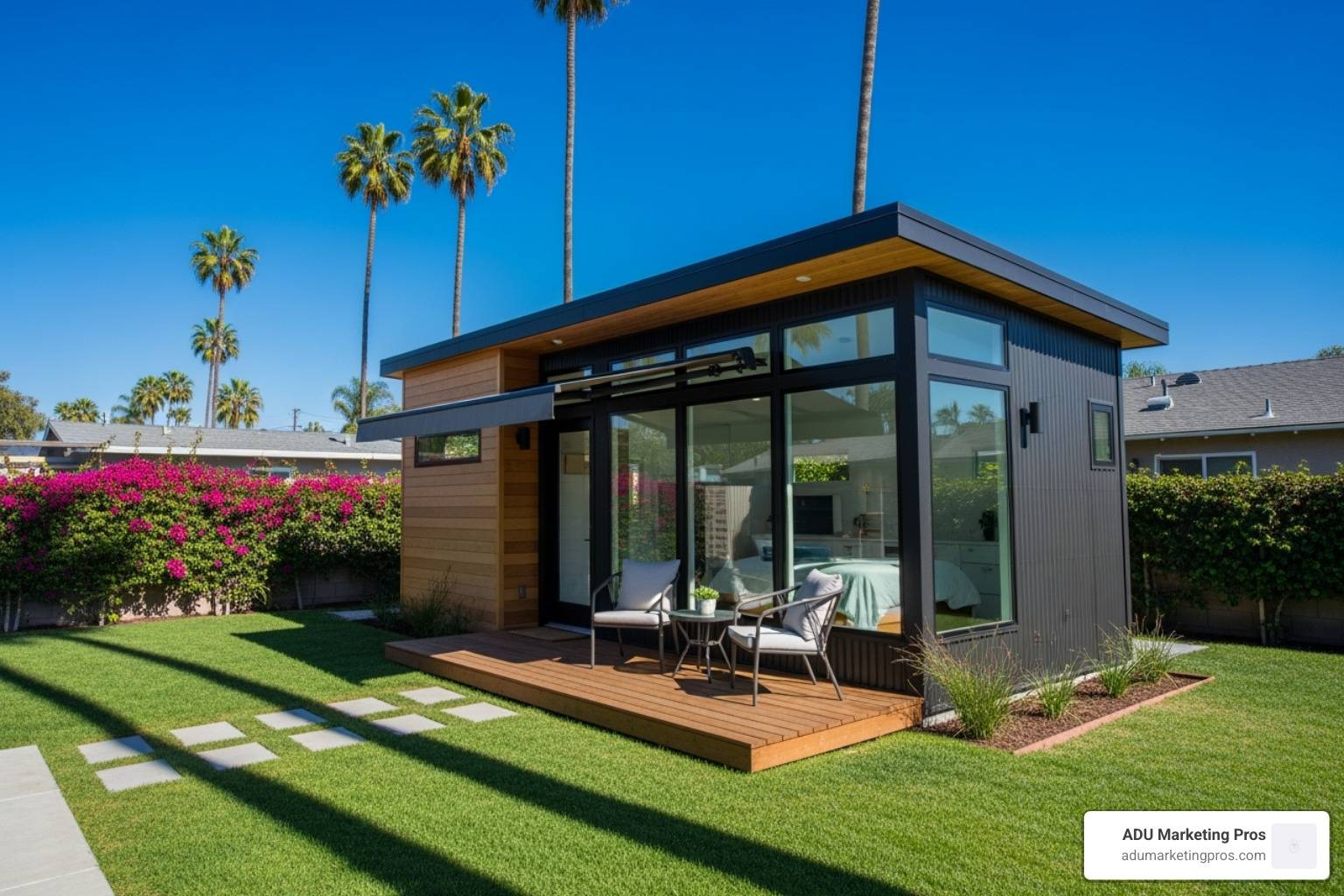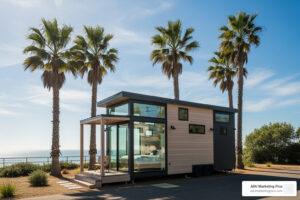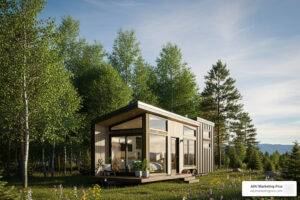Why Prefab Granny Flats Are Revolutionizing California Housing
Prefab granny flat california projects are changing how homeowners approach accessory dwelling units (ADUs). These factory-built homes offer a faster, more predictable, and often more affordable path to adding living space than traditional construction.
Quick Facts About Prefab ADUs in California:
- Cost: $50,000-$200,000+ total project cost.
- Timeline: 4-8 weeks for factory construction vs. 6+ months for stick-built.
- Size: Typically 600-1,200 sq ft.
- Installation: A few days to a week on-site.
- Value: Appraise equally to site-built ADUs.
With California’s housing crisis fueling interest in ADUs and state laws now allowing at least one 800 sq ft granny flat on most residential properties, prefab construction has emerged as a leading solution. Building in a controlled factory environment minimizes weather delays, material waste, and neighborhood disruption.
However, not all prefab ADUs are created equal. A successful project hinges on choosing the right builder and understanding California’s specific ADU regulations. This guide will walk you through everything you need to know.
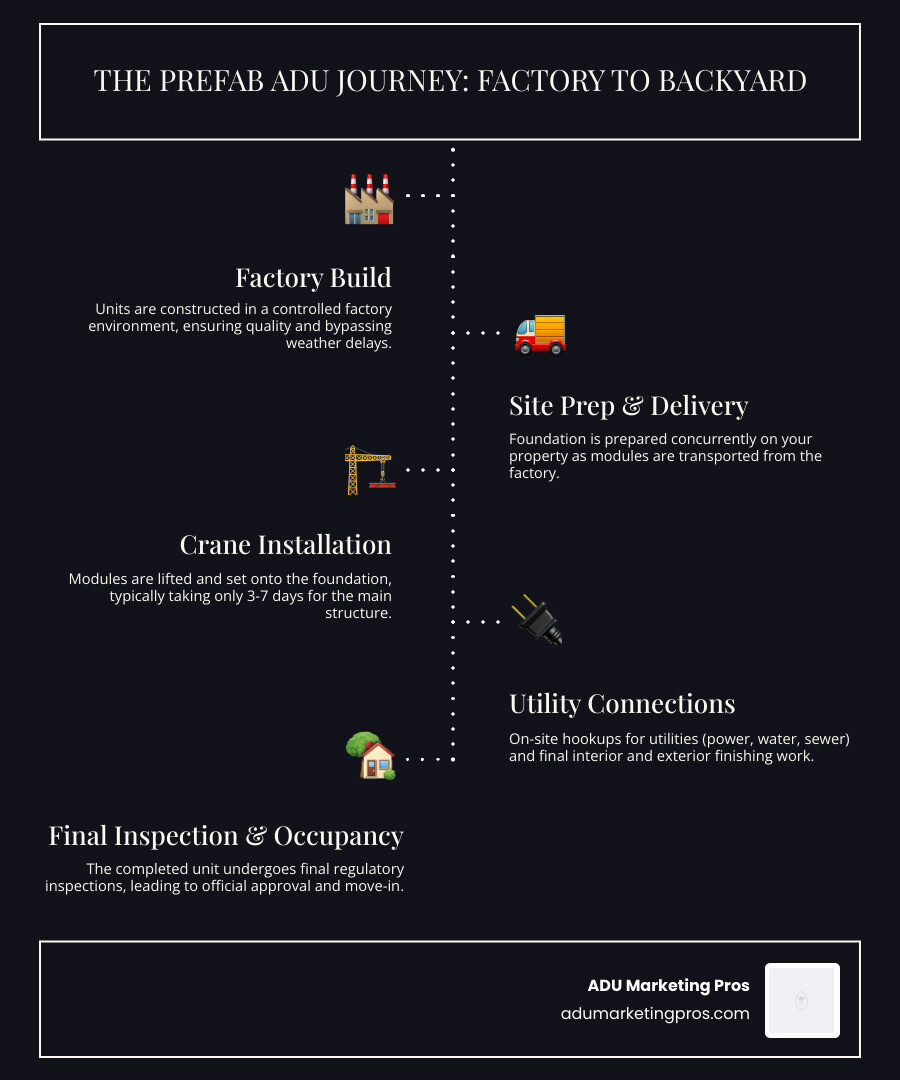
Know your prefab granny flat california terms:
What is a Prefab Granny Flat?
A prefab granny flat, also known as an Accessory Dwelling Unit (ADU), is a self-contained living space built on your property, with the key difference being that it’s largely manufactured off-site in a factory. This method offers major advantages in quality control and efficiency over traditional “stick-built” construction.
There are two primary types of prefab construction:
- Modular: The ADU is built in large, nearly complete sections (modules) in a factory, including plumbing, wiring, and finishes. These modules are then transported to your site and craned onto a foundation.
- Panelized: The walls, floors, and roof are built as panels in a factory. These panels are shipped to your property and assembled on-site, offering a bit more flexibility for on-site adjustments.
Regardless of the method, every prefab granny flat california project must meet the same strict California Building Codes (CBC) as a traditional home, ensuring safety and quality.
| Feature | Prefab ADUs | Traditional Stick-Built ADUs |
|---|---|---|
| Cost | Often more cost-effective (total $50K-$200K+) | Can be more expensive (often $150K-$300K+) |
| Timeline | Much faster (factory build in weeks, on-site install in days) | Slower (typically 6-8 months or longer) |
| Disruption | Minimal on-site noise, mess, and traffic | Significant disruption for many months |
| Customization | Good, with many pre-defined models and finish options | High, with nearly limitless design flexibility |
The Prefab Process and Design
The magic of prefab lies in its parallel workflow. While your ADU is being built in a factory, site preparation (foundation, utilities) happens simultaneously in your backyard. This drastically cuts down the overall project timeline from start to finish.
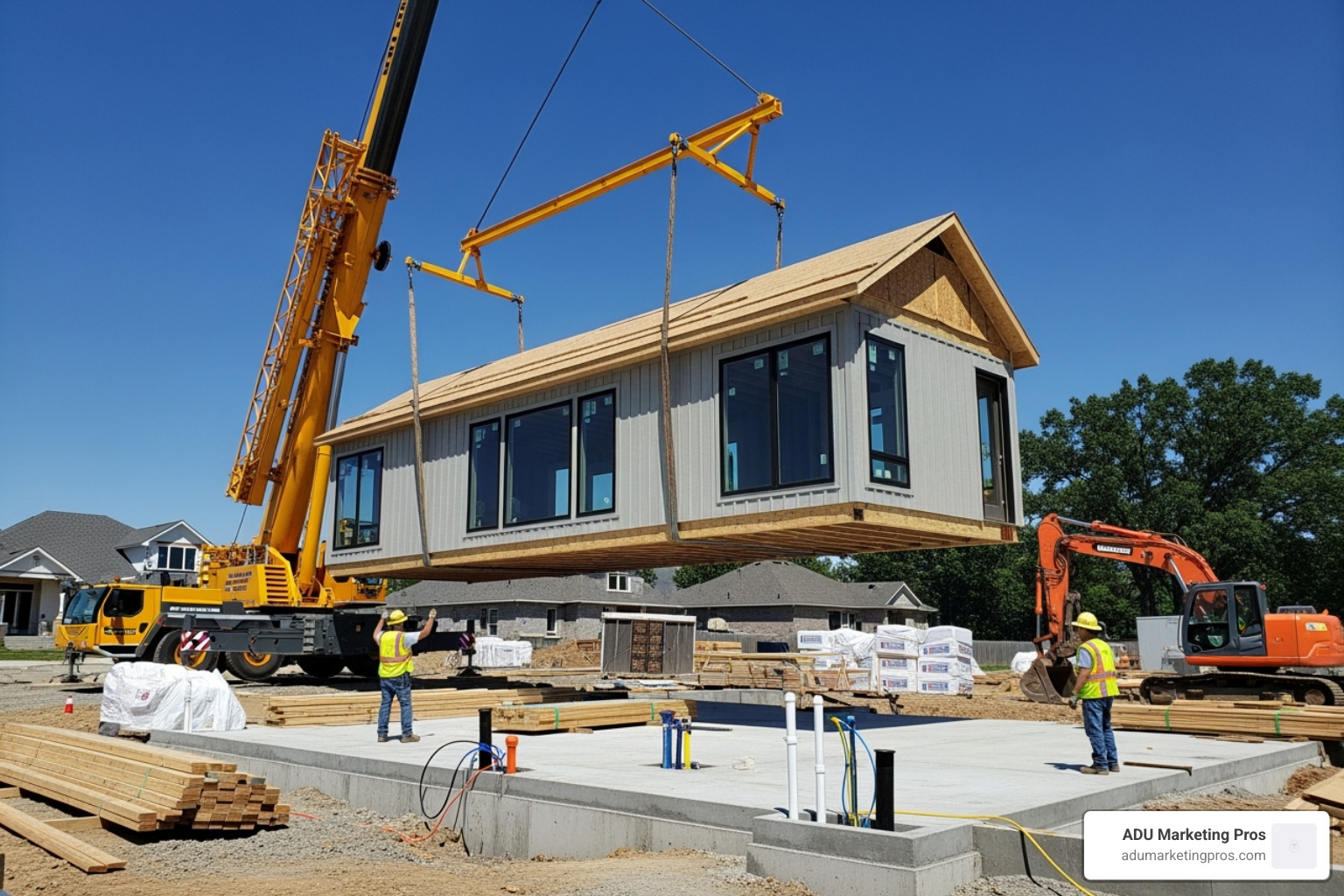
Contrary to the myth that prefab means “cookie-cutter,” modern manufacturers offer a surprising amount of customization. You can typically choose from a wide range of:
- Layouts: From cozy 600 sq ft one-bedrooms to spacious 1,200 sq ft two-bedroom designs.
- Finishes: Select your own flooring, cabinets, countertops, and paint colors.
- Fixtures: Customize lighting, plumbing fixtures, and hardware.
- Exteriors: Match your main home with options like lap siding, stucco, or modern panels.
Many builders also specialize in accessibility features for aging-in-place, such as step-less entries, wider doorways, and roll-in showers, making them a perfect long-term solution for families.
Curious how ADUs fit into the broader tiny home movement? Learn more about the differences between ADUs and other small living spaces: ADU vs Tiny House.
Ready to explore the possibilities for your backyard? Dive into various design ideas for your ADU: Granny Flat Designs.
The Pros and Cons of Choosing a Prefab Granny Flat in California
Adding a prefab granny flat california is a significant investment in both your finances and lifestyle. It can provide a home for family, a private office, or a source of rental income. In California’s competitive housing market, these units offer valuable flexibility.

Key Advantages
- Speed of Construction: Factory building takes weeks, not months. On-site installation is often completed in just a few days, minimizing disruption.
- Cost Savings: Efficient factory processes reduce labor costs and material waste, often making prefab a more budget-friendly option.
- Predictable Timeline and Budget: A controlled environment eliminates weather delays and other common on-site surprises, keeping your project on track.
- Durability and Seismic Resistance: Built to withstand transportation, these structures are inherently robust and well-suited for California’s seismic zones.
- Eco-Friendly: Many builders use sustainable materials and processes that reduce construction waste and improve energy efficiency.
Want to learn more about the broader benefits of adding an ADU? Read more about ADU benefits.
Potential Disadvantages to Consider
- Site Accessibility: Narrow streets, power lines, or sloped lots can make it difficult or impossible to deliver large modular units via crane.
- Limited Design Changes: Once production begins, major design alterations are difficult and costly. All decisions must be finalized upfront.
- Financing: Some traditional lenders may be less familiar with prefab construction, though financing options are rapidly expanding.
- Finding Experienced Installers: Installation requires specialized skills. It’s crucial to hire a contractor with proven experience in prefab ADUs.
Are Prefab ADUs a Good Investment?
Absolutely. A prefab granny flat california is an excellent investment. It significantly increases your property value, with appraisers valuing them the same as stick-built ADUs. The potential for substantial rental income in California’s high-demand market provides a strong return on investment (ROI). As a permanent structure, your ADU will appreciate in value along with the broader real estate market, making it a smart, future-proof addition to your property.
Navigating California’s ADU Rules and Regulations
California has streamlined ADU laws to encourage construction, but understanding the rules is key to a smooth project. While state laws set the foundation, local city and county ordinances may have specific requirements.
Statewide California ADU Guidelines You Need to Know
State laws generally override more restrictive local rules. Key provisions include:
- Ministerial Approval: If your ADU plan meets all objective standards, the local agency must approve it without a discretionary hearing.
- Fast-Track Permitting: Local agencies must act on a completed ADU permit application within 60 days.
- No Owner-Occupancy: Since 2020, owners are not required to live on the property, making ADUs ideal for rental investments.
For advocacy and detailed information, The Casita Coalition is an excellent resource for homeowners.
Size Limits, Setbacks, and Parking
When planning your prefab granny flat california, keep these key state standards in mind:
- Size: You can build at least one 800 sq ft ADU. The maximum size for a detached ADU is generally 1,200 sq ft.
- Setbacks: State law allows for setbacks as minimal as 4 feet from the side and rear property lines.
- Height: Detached ADUs are typically limited to 16 feet in height, though this can vary by locality.
- Parking: No additional parking is required if the ADU is near public transit, in a historic district, or in other qualifying situations. Otherwise, one space per unit is the standard.
Always check your local ordinance, as rules can vary. The CA Dept. of Housing and Community Development website is a great place to start.
The ADU Permit Process and Fees
State law has simplified the permit process and reduced costs.
- Process: Submit your plans for a 60-day ministerial review. Once approved, you’ll receive permits and can begin construction, with inspections conducted at key stages.
- Fees: A major cost saving is the waiver of impact fees for ADUs under 750 sq ft. For larger units, fees are proportional to the ADU’s size. You will still be responsible for standard plan check and building permit fees.
- Solar: Most new ADUs in California are required to have a solar photovoltaic (PV) system, which adds to the upfront cost but provides long-term energy savings.
The Financial Breakdown: Cost and Timeline for a Prefab Granny Flat California Project
Understanding the true cost and timeline is essential when planning your prefab granny flat california project. While every project is unique, we can provide a clear breakdown of what to expect.
For a custom estimate, try our ADU Cost Calculator.
What’s the All-In Cost?
The total project cost for a prefab ADU typically ranges from $50,000 to $200,000+. The prefab unit itself is only one part of the equation. The “all-in” price includes several components:
- Prefab Unit/Kit: The cost of the factory-built structure, based on size, design, and finishes.
- Site Preparation: Grading, excavation, and foundation work. Costs can increase for sloped or difficult lots.
- Transportation: Delivery of the modules or panels from the factory to your property.
- Installation & Crane Rental: The cost to set the unit on the foundation. Crane rental for modular units can be a significant expense.
- Utility Hookups: Connecting water, sewer, electricity, and gas to the new unit.
- Permits and Fees: Local government fees for plan review, permits, and (for units over 750 sq ft) impact fees.
- Finishing Work: On-site work like sealing seams, paint touch-ups, and landscaping.
Understanding the Project Timeline
Speed is a major advantage of prefab. A typical project can be completed in just 3 to 5 months from start to finish, compared to 6-8+ months for a traditional build.
- Design & Permitting (2-4 months): The longest phase, involving design finalization and local agency approval.
- Factory Construction (4-8 weeks): Your ADU is built efficiently in a controlled environment.
- Site Preparation (2-4 weeks): This happens concurrently with factory construction to save time.
- Delivery & Installation (1 week): The exciting part where your home is delivered, set, and connected.
- Final Inspections (1-3 weeks): Final checks by local inspectors before you get the keys.
Exploring ADU Financing Options
Funding your prefab granny flat california is manageable with several common options:
- Construction Loans: Short-term loans designed for building projects.
- Home Equity Loan or Line of Credit (HELOC): Use the equity in your existing home to fund the ADU.
- Cash-Out Refinance: Refinance your current mortgage for a larger amount and use the difference for your project.
- Renovation Loans: Loans like the FHA 203(k) bundle the cost of the ADU into your mortgage.
- Builder Financing: Many prefab companies offer in-house financing or partner with lenders familiar with their products.
How to Choose the Right Builder and Kit
Selecting the right partners and materials is the most critical step in your prefab granny flat california project. Due diligence ensures you get a high-quality home and a smooth experience.
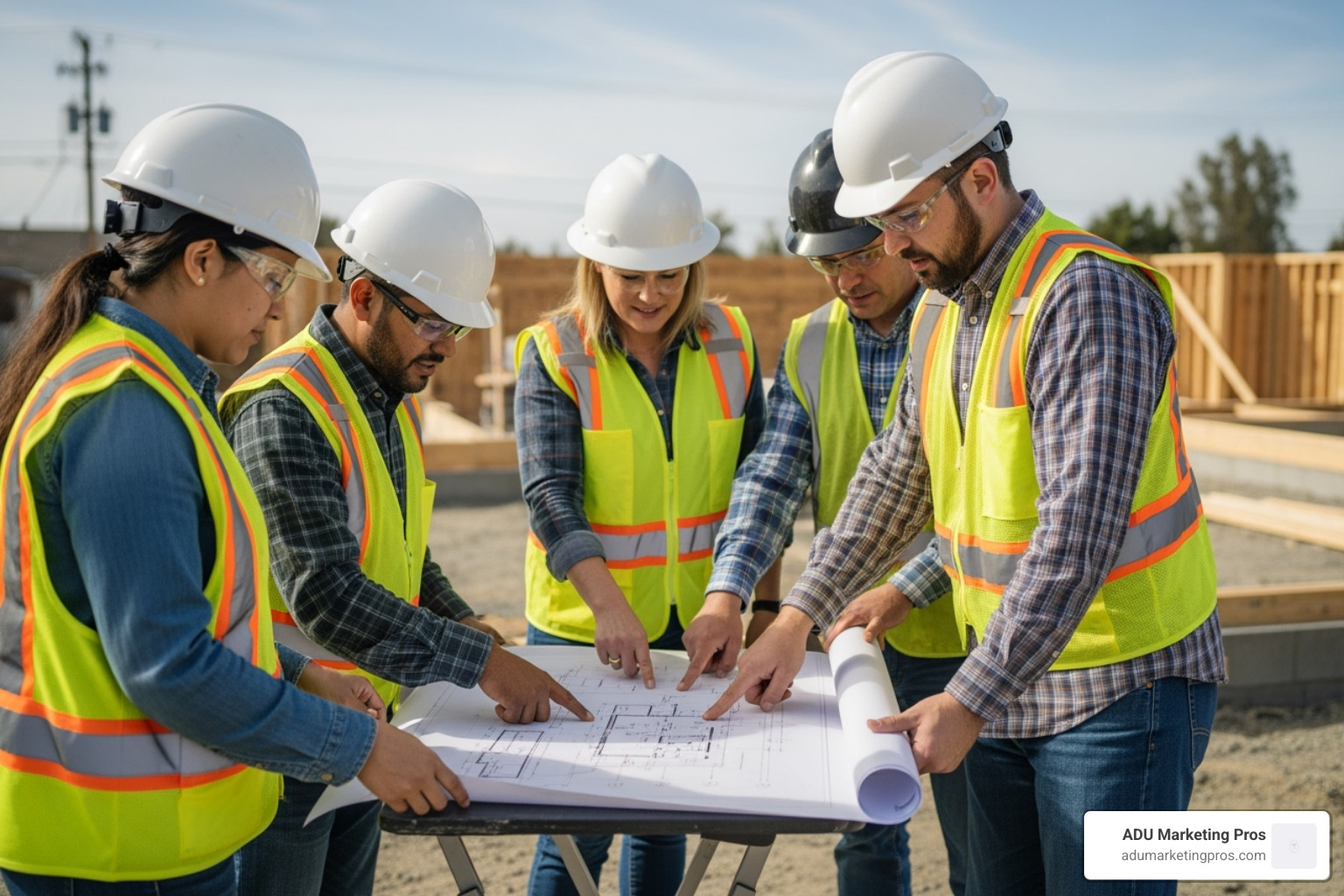
Vetting ADU Builders Near Me: Key Questions for Your Prefab Granny Flat California Project
When interviewing potential builders, focus on their specific experience with prefab construction. Ask these key questions:
- Licensing and Insurance: Are you a licensed General Contractor in California? Can you provide proof of liability and worker’s compensation insurance?
- Prefab Experience: How many prefab ADUs have you installed? Can you show us a portfolio of completed projects?
- Client References: Can we speak with 2-3 of your recent clients about their experience?
- Local Code Knowledge: How familiar are you with the ADU ordinances in my specific city (e.g., San Jose, Los Angeles, San Diego)?
- Process and Communication: What is your process for managing the project, and how will you keep me updated?
Evaluating Prefab Kits and ADU Building Plans
Not all kits are created equal. When reviewing your options, look for:
- Materials Quality: What materials are used? Are they durable, sustainable, and compliant with California building codes?
- Inclusions vs. Exclusions: What exactly is included in the kit price? (e.g., appliances, fixtures, delivery).
- Warranty: What warranties are offered on the structure and its components?
- Engineering Standards: Is the unit engineered for California’s seismic zones and other environmental factors?
- Energy Efficiency: What are the insulation values (R-values) and window efficiency ratings? Does the design help reduce long-term utility costs?
- Floor Plan Functionality: Does the layout meet your needs for flow, storage, and natural light?
Frequently Asked Questions about Prefab Granny Flats
Here are concise answers to the most common questions homeowners have about building a prefab granny flat california.
How long does the on-site installation of a prefab granny flat take?
The on-site phase is remarkably fast. After the foundation is prepared, the actual installation, including craning the modules into place, connecting utilities, and finishing touches, typically takes only one to two weeks. This is a dramatic reduction from the months of on-site work required for a traditional build.
Do prefab granny flats hold their value as well as traditional homes?
Yes. Once installed on a permanent foundation, a prefab ADU is considered real property, just like a site-built home. Appraisers value it based on its size, quality, and features, not its construction method. A prefab granny flat california will appreciate in value right along with your primary home and the local real estate market.
Can I legally rent out my prefab granny flat in California?
Absolutely. California state law fully supports the rental of ADUs to help address the housing shortage. You can legally rent your unit for long-term tenancy. Furthermore, a 2020 law eliminated owner-occupancy requirements, meaning you don’t have to live in either the main house or the ADU. However, regulations for short-term rentals (like Airbnb) vary by city and county, so you must check your local rules.
Conclusion
As we’ve explored, prefab granny flat california projects offer a approach to adding living space. They provide a faster, more cost-effective, and less disruptive alternative to traditional construction, making them an ideal solution for homeowners looking to house family, create a home office, or generate rental income.
From navigating California’s progressive ADU laws to understanding the finances and choosing the right team, building a high-quality, durable ADU is more accessible than ever. Prefab construction is a key part of the solution to housing needs in the Golden State.
As the ADU market grows, it’s crucial for builders and architects to stand out. ADU Marketing Pros helps the best firms connect with homeowners like you, showcasing their expertise and quality. We ensure that families can find trusted professionals to build their new space—whether it’s for granny, a grown child, or a happy tenant.
Ready to take the next step? Explore the possibilities for your own backyard by learning about different types of ADU Modular Homes California. Your perfect prefab granny flat california might be closer than you think!

